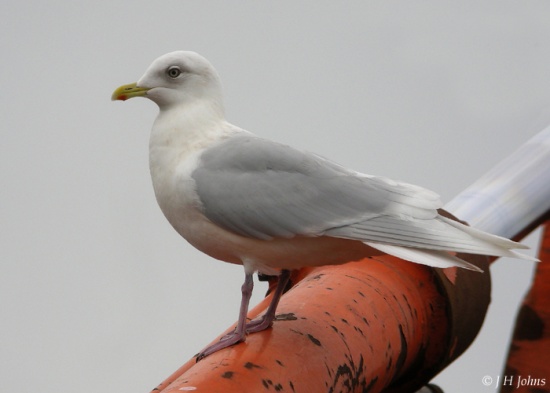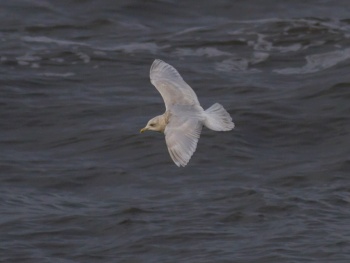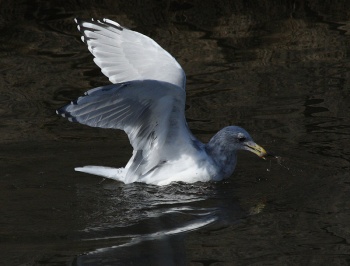- Larus glaucoides
Includes: Kumlien's Gull and Thayer's Gull
Identification
55–64 cm, 21.7 inches. 557–863 g, 19.6-30.4 oz. Wingspan 125–130 cm, 49-51 inches.
- The Iceland Gull matures in 4 years
Breeding Adult
- Mainly white with a pale grey mantle, upperwing-coverts and flight-feather bases
- White tips to flight feathers
- Yellow beak with red gonys-spot
- Pink legs
- Yellow iris
- Red orbital ring
Non-breeding Adult
- Streaked brown spots or streaks on head to upper breast
Juvenile and First Winter
- Very pale, more uniform than Glaucous Gull,
- Head can be dark
- Mantle, scapulars, tertials, upperwing coverts inconstantly marked with brownish barring or spots
- Rump and undertail-coverts barred brownish
- Tail with a few grey subterminal bands or one pale grey terminal band
- Beak dark brownish to brownish flesh coloured, normally paler at base than tip, but not as cleanly demarcated as in Glaucous Gull
Second Winter
- Similar to first winter, but paler head and body with dark mask and pale eye
- Some birds have adult-like grey mantle and scapulars giving a saddle-like appearance
- Tail frequently grey tingued
- Beak pale with dark subterminal bar
Third Winter
- Paler and less patterned than first winter or juvenile, but there is much individual variation
- Whitish head and body
- Mantle and inner upper-wing coverts shows a varying degree of pale grey
Fourth Winter
- Similar to adult with brown tinge to the upperwing coverts
- Possibly traces of dark marking on undertail-coverts
- Beak darker yellow than adult, with solid black marking.
Similar Species
- Plumage pattern is similar to that of the far bigger Glaucous Gull but:
- Beak is shorter and thinner
- At rest, the wingtips extend well past tail
- Smaller than many European Herring Gull, but size overlaps, no black on primaries
Subspecies kumlieni
- Adults of the slightly larger-billed race L. g. kumlieni have darker red orbital ring and dark iris
- Contrasting darker grey outer webs to outer primaries 10 and 9,
- Grey tips to primaries 8 and 7, this is very variable
- Some individuals in kumlieni colonies have all white wingtips
- Some have almost uniform grey primaries
- Darkest individuals could be hybrids with thayeri
- Immatures have darker tips to primaries
- More coarse patterning than nominate, but mainly hard to separate
- Hybrid European Herring Gull x Glaucous Gull is very similar to kumlieni, but larger, with stronger beak
Subspecies thayeri
- Clearly darker than kumlieni and nominate
Distribution
Breeds in Greenland and northeastern Canada; winters south to Iceland, northwestern Europe, and northeastern United States.
Taxonomy
Three subspecies are currently accepted[1][2]:
- Larus glaucoides glaucoides (Iceland Gull)
- Larus glaucoides kumlieni (Kumlien's Gull)
- Breeds arctic northeastern Canada (mainly southeast Baffin Island), winters northeastern North America, and (rare) Iceland and northwestern Europe.
- Larus glaucoides thayeri (Thayer's Gull)
The taxonomy is complex, and due to the inaccessibility of the breeding colonies in the high Arctic, still not yet well researched. Kumlien's Gull is very variable, forming an almost complete cline between the nominate and thayeri, and appears to be a hybrid swarm between them. Thayer's Gull was formerly treated as full species. A few authors have further suggested that Thayer's Gull itself is an intergrade between Iceland Gull and American Herring Gull.
Habitat
Coasts, fjords, cliffs and stacks in the low Arctic. Occasionally undisturbed low lying islands. In winter associates with other gulls at fishing harbours, landfills, rivers, and reservoirs, but usually avoids fresh water.
Behaviour
Diet
Largely small fish, e.g. salmon (Salmo), sprat (Sprattus), herring (Clupea) and marine invertebrates, eggs and chicks of other birds, occasionally seeds and fruits. Scavenges in intertidal zone and visits stranded carcasses. Some individuals specialize on Black-legged Kittiwake colonies, predating unsupervised eggs and chicks. Wintering birds often visit rubbish dumps and sewage outfalls. Usually a water surface feeder, but sometimes by plunge-divingand forages on ground surfaces.
Breeding
2-3 light brown eggs are laid from mid-May to mid-June in Greenland. Solitary or in small colonies. On cliff ledge, sometimes on ground. Usually nests on steep cliffs over 100 m in height. In mixed colonies with the Black-legged Kittiwake it usually nests higher up the cliff, choosing wider ledges. In Greenland it commonly nests with Glaucous Gull. Cliff-nesting birds behave like Kittiwakes, whereas the ground nesting birds act more like European Herring Gull. Nests are built with seaweed, mosses and dry grass.
Incubation and fledging times are unrecorded and the chicks are not described. Chicks preferto face outwards from cliff face and they are not recognized by adults until about 19 days. Cliff nesting chicks remain still when disturbed, while their ground nesting cousins run about. Fledging in late July chicks move to coastal feeding areas with adults.
Movement
Northern populations are migratory, but populations of S Greenland are resident. Post-breeding birds remain in the colony area until August or September. Young birds move further than adults. Numbers reaching the southern limits of the wintering range vary annually, with influxes in some winters. An exceptional influx into northwest Europe happened in January–February 2012 when thousands reached the Faroe Islands and hundreds reached northern Britain. Many of the first birds toarrive were in poor condition. This suggests a food shortage in their normal winter range.
Birds from east Greenland are more migratory than those in the west of that country, the eastern population moving largely from inland fjords to coastal areas post breeding and disperse along the coast in winter. Some Greenland nominates move to northeastern North America travelling as far south as New England, most fly to Iceland, where they are found in large numbers in winter, the Faeroes, and some go on to northwest Europe, including the British Isles and The Netherlands. Vagrants have been recorded in most other European countries, including Austria, Belgium, Finland, France, Germany, Gibraltar, Greece, Hungary, Italy, Latvia, Macedonia, Norway, Poland, Portugal, Romania, the Russian Federation, Slovakia, Spain and Sweden. Several have reached Morocco and a few have been recorded in the Canary Islands and Madeira.
The subspecies L. g. kumlieni is a very rare but regular winter visitor to Iceland, the Faroes and the British Isles and a vagrant to other lands in Europe.
L. g. kumlieni from Baffin Island head south to Hudson Bay, and onwards to the Maritime Provinces, wintering from Labrador to the eastern Great Lakes and Virginia, some individuals reach Florida and the Gulf coast. Others reach Alaska and the Pacific coast in Canada, a few turning up in California. Most birds that arrive in New England and the Mid-Atlantic states are juveniles. These normally mix with American Herring Gull in harbours and rubbish dumps.
Vocalisation
Similar to European Herring Gull or American Herring Gull, but shriller
References
- Clements, J. F., T. S. Schulenberg, M. J. Iliff, D. Roberson, T. A. Fredericks, B. L. Sullivan, and C. L. Wood. 2017. The eBird/Clements checklist of birds of the world: v2017, with updates to August 2017. Downloaded from http://www.birds.cornell.edu/clementschecklist/download/
- Avibase
- Gill, F and D Donsker (Eds). 2014. IOC World Bird Names (version 4.4). Available at http://www.worldbirdnames.org/.
- Handbook of the Birds of the World Alive (retrieved December 2016)
- Del Hoyo, J, A Elliot, and J Sargatal, eds. 1996. Handbook of the Birds of the World. Volume 3: Hoatzin to Auks. Barcelona: Lynx Edicions. ISBN 978-8487334207
- Helm Identification Guides Gulls of Europe, Asia and North America Klaus Malling Olsen and Hans Larsson ISBN 978-0-7136-7087-5
Recommended Citation
- BirdForum Opus contributors. (2025) Iceland Gull. In: BirdForum, the forum for wild birds and birding. Retrieved 17 May 2025 from https://www.birdforum.net/opus/Iceland_Gull
External Links
Search the Gallery using the scientific name:
Search the Gallery using Iceland Gull:
Search the Gallery using Kumlien's Gull:
Search the Gallery using Thayer's Gull:
GSearch checked for 2020 platform.






